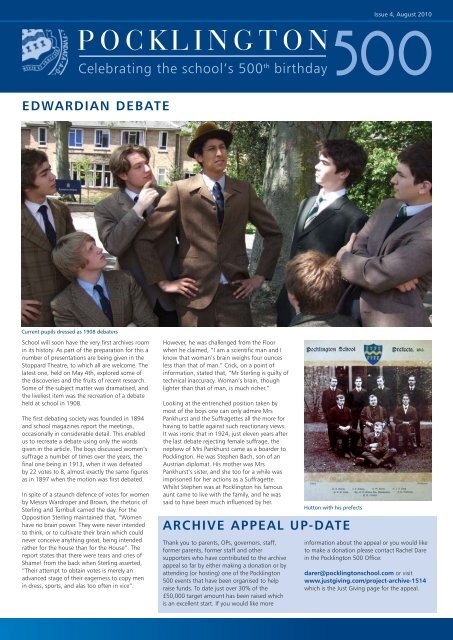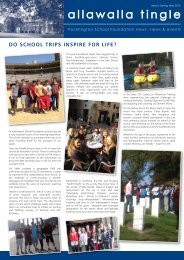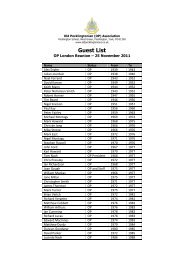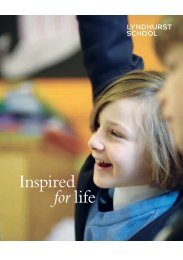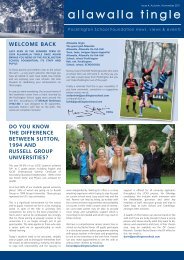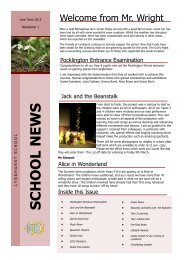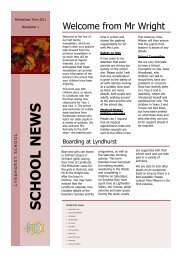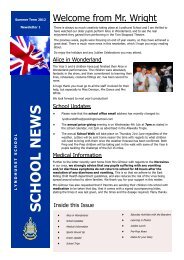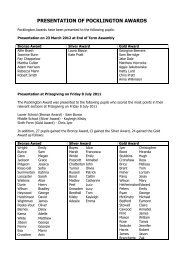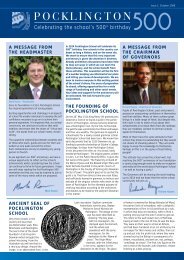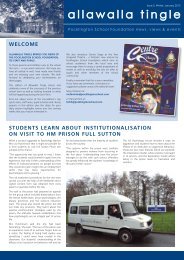Pock 500 ed.4 - outer low - Pocklington School
Pock 500 ed.4 - outer low - Pocklington School
Pock 500 ed.4 - outer low - Pocklington School
You also want an ePaper? Increase the reach of your titles
YUMPU automatically turns print PDFs into web optimized ePapers that Google loves.
Issue 4, August 2010<br />
EDWARDIAN DEBATE<br />
Current pupils dressed as 1908 debaters<br />
<strong>School</strong> will soon have the very first archives room<br />
in its history. As part of the preparation for this a<br />
number of presentations are being given in the<br />
Stoppard Theatre, to which all are welcome. The<br />
latest one, held on May 4th, explored some of<br />
the discoveries and the fruits of recent research.<br />
Some of the subject matter was dramatised, and<br />
the liveliest item was the recreation of a debate<br />
held at school in 1908.<br />
The first debating society was founded in 1894<br />
and school magazines report the meetings,<br />
occasionally in considerable detail. This enabled<br />
us to recreate a debate using only the words<br />
given in the article. The boys discussed women’s<br />
suffrage a number of times over the years, the<br />
final one being in 1913, when it was defeated<br />
by 22 votes to 8, almost exactly the same figures<br />
as in 1897 when the motion was first debated.<br />
In spite of a staunch defence of votes for women<br />
by Messrs Wardroper and Brown, the rhetoric of<br />
Sterling and Turnbull carried the day. For the<br />
Opposition Sterling maintained that, “Women<br />
have no brain power. They were never intended<br />
to think, or to cultivate their brain which could<br />
never conceive anything great, being intended<br />
rather for the house than for the House”. The<br />
report states that there were tears and cries of<br />
Shame! from the back when Sterling asserted,<br />
“Their attempt to obtain votes is merely an<br />
advanced stage of their eagerness to copy men<br />
in dress, sports, and alas too often in vice”.<br />
However, he was challenged from the Floor<br />
when he claimed, “I am a scientific man and I<br />
know that woman’s brain weighs four ounces<br />
less than that of man.” Crick, on a point of<br />
information, stated that, “Mr Sterling is guilty of<br />
technical inaccuracy. Woman’s brain, though<br />
lighter than that of man, is much richer.”<br />
Looking at the entrenched position taken by<br />
most of the boys one can only admire Mrs<br />
Pankhurst and the Suffragettes all the more for<br />
having to battle against such reactionary views.<br />
It was ironic that in 1924, just eleven years after<br />
the last debate rejecting female suffrage, the<br />
nephew of Mrs Pankhurst came as a boarder to<br />
<strong>Pock</strong>lington. He was Stephen Bach, son of an<br />
Austrian diplomat. His mother was Mrs<br />
Pankhurst’s sister, and she too for a while was<br />
imprisoned for her actions as a Suffragette.<br />
Whilst Stephen was at <strong>Pock</strong>lington his famous<br />
aunt came to live with the family, and he was<br />
said to have been much influenced by her.<br />
Thank you to parents, OPs, governors, staff,<br />
former parents, former staff and other<br />
supporters who have contributed to the archive<br />
appeal so far by either making a donation or by<br />
attending (or hosting) one of the <strong>Pock</strong>lington<br />
<strong>500</strong> events that have been organised to help<br />
raise funds. To date just over 30% of the<br />
£50,000 target amount has been raised which<br />
is an excellent start. If you would like more<br />
Hutton with his prefects<br />
ARCHIVE APPEAL UP-DATE<br />
information about the appeal or you would like<br />
to make a donation please contact Rachel Dare<br />
in the <strong>Pock</strong>lington <strong>500</strong> Office:<br />
darer@pocklingtonschool.com or visit<br />
www.justgiving.com/project-archive-1514<br />
which is the Just Giving page for the appeal.
PATRONS<br />
We are delighted to announce that a<br />
number of friends of <strong>Pock</strong>lington <strong>School</strong><br />
Foundation have kindly accepted the<br />
Headmaster’s invitation to become a<br />
patron.<br />
The Honourable Mrs Susan Cunliffe-Lister,<br />
Lord Lieutenant of East Yorkshire, was the<br />
guest of honour at our prizegiving in 2009. She<br />
was appointed High Sheriff in East Yorkshire in<br />
2001, the first woman to hold this office since<br />
its origin in Anglo Saxon times.<br />
Professor Christopher Dobson is professor of<br />
Chemical and Structural Biology at the University<br />
of Cambridge, and has been Master of St John’s<br />
College since 2007. The school’s foundation<br />
charter is held in the college library and is a<br />
testament to the long and active relationship<br />
between school and college.<br />
Mr Brian Fenwick-Smith is an OP,<br />
entrepreneur and school benefactor. He has<br />
assisted the school in ‘masterplanning’ recent<br />
developments to the campus and his generosity<br />
al<strong>low</strong>ed the school to build a very fine and much<br />
admired senior boys’ boarding house.<br />
Fenwick-Smith House was opened in 2007.<br />
The Right Honourable the Earl of Halifax is<br />
a Governor of <strong>Pock</strong>lington <strong>School</strong> Foundation<br />
and a Deputy Lord Lieutenant for East Yorkshire.<br />
Lord Halifax is also High Steward of York Minster<br />
and a J.P. Lord Halifax has been a close supporter<br />
of the school over many years.<br />
The Very Reverend Keith Jones, Dean of York.<br />
In the early years of the school’s foundation the<br />
Dean was one of the few individuals who could<br />
discipline the Headmaster of <strong>Pock</strong>lington <strong>School</strong>!<br />
In 2007 the school choir was invited by the<br />
Minster to take part in its Wilberforce<br />
celebrations and in the time ahead we<br />
hope to strengthen the friendship.<br />
We thank each of them for their support and<br />
look forward to their involvement in our<br />
celebrations.<br />
Andrew Dawes<br />
MAN. To show a dove above a man would be a<br />
more satisfying rebus.<br />
In a letter to the school in 1950, the Chester<br />
Herald reported that “the original Grant of Arms<br />
to John Dowman has been traced… The arms<br />
are blazoned as fol<strong>low</strong>s: Azure a fesse dancette<br />
between eight garbs or, banded gules, on the<br />
fesse three doves of the field beaked and<br />
membered.” That is a blue field with a gold<br />
zigzag between eight gold wheat sheaves with<br />
red bands round them. On the zigzag three<br />
doves in their natural colours, with beaks and<br />
feet.<br />
THE FOUNDER’S COAT OF ARMS<br />
The recent discovery of the school’s Foundation<br />
Document of 1514 in St. John’s College Library<br />
was an event of great significance for us. A<br />
report of the document was given in the last<br />
issue of ‘<strong>Pock</strong>lington <strong>500</strong>’. The majority of the<br />
text is in Latin, and this has been painstakingly<br />
translated by two OPs, David Stather and Keith<br />
Walls.<br />
One intriguing aspect of the document is the<br />
carefully ruled off blank square near the end.<br />
Into this space at some point a coat of arms<br />
has been drawn. The drawing is amateurish and<br />
hurried – so very different from the beautiful<br />
and assured script used throughout. In one<br />
significant way the arms differ from the version<br />
the school uses. But first it might be useful to<br />
look at the arms we use today.<br />
In 2007 the Somerset Herald wrote to the school<br />
confirming the Dowman arms as ‘azure, a fess<br />
dancetty between eight garbs or banded gules’.<br />
This means a blue background to the shield with<br />
gold zigzag across the middle and eight wheat<br />
sheaves, four above the zigzag, four be<strong>low</strong>, each<br />
of them with a red band around it.<br />
However, the arms in the Foundation Document<br />
show three birds on the fess. These birds are<br />
doves, and in the days before regularised<br />
spelling, the family used a number of variants<br />
for their name: Dowman, Dolman, Dowlman<br />
and Doveman. It could be that this was the<br />
version of the family arms created by our<br />
Founder as his own.<br />
Did he himself draw this sketch? If the coat of<br />
arms had been granted to his father, or was<br />
even earlier, was John Dowman seeking to<br />
produce a difference in the customary way? The<br />
space in the document certainly looks as though<br />
it has been left for a coat of arms, but it has not<br />
been professionally, or even competently, drawn.<br />
The four garbs be<strong>low</strong> the awkwardly drawn fess<br />
are not spaced evenly as they are in all other<br />
versions.<br />
One intriguing detail is the smiley face added to<br />
the left-hand side garb. Could this be Dowman<br />
trying to create a rebus, that is a pictorial play on<br />
his name - Dove - man? An account of the<br />
school written in the nineteenth century says<br />
that in the early 1800s there was a rebus on one<br />
of the beams - be<strong>low</strong> the three doves the letters<br />
Almost the same information has come from an<br />
early document seen by the school: Azure on a<br />
fesse dancette between eight garbs or three<br />
birds close of the field beaked and membered<br />
gules. Crest on a bezant a bird as in the arms.<br />
In addition, therefore, we learn that the birds’<br />
feet and beaks were red, and that there was<br />
also a crest - a bird on a gold coin. The latter is<br />
certainly different from the crest shown on most<br />
other examples of the family’s coat of arms.<br />
In an attempt to sort out the school’s use of<br />
the Dolman heraldry, Alan Heaven was asked<br />
to examine the subject and produce a report.<br />
He drew these three conclusions:<br />
1. The arms which the school presently uses,<br />
in various corrupted forms, are those of<br />
the Dolman family.<br />
2. The arms are not those of the founder,<br />
John Dowman.<br />
3. The school has been using arms to which<br />
it has no right and has no grant of arms of<br />
its own.<br />
He added that “The closing line must be that the<br />
school should petition for new arms”. The <strong>500</strong>th<br />
anniversary would seem to be a good time to do<br />
so. There is, however, a cost to such an initiative,<br />
and we have been advised it would be in the<br />
region of £5,000. We will add this suggestion to<br />
our wish list, a list we are soon going to need to<br />
put in order of priority.<br />
Copies of the full text of Alan Heaven’s<br />
paper, ‘A Survey of the Heraldry of<br />
<strong>Pock</strong>lington <strong>School</strong>’, can be obtained<br />
on request.
FROM THE ARCHIVES<br />
In setting up the new archives room we are not<br />
concentrating solely on the written word. Other<br />
aspects of the school’s heritage are being added<br />
to the collections and cared for.<br />
A catalogue of other items is being prepared<br />
and will be useful when regular checks are<br />
made. Most of these possessions are spread<br />
throughout the school – portraits mainly in the<br />
Library and Gruggen Room for instance, the<br />
former railway clock in Lyndhurst, stained glass<br />
in the Chapel and Music <strong>School</strong>, and so on.<br />
Early photographs show other pieces that we<br />
have so far been unable to trace. For example,<br />
quite a number of fittings the school acquired<br />
when the railway station was purchased can’t<br />
now be identified.<br />
We illustrate one piece of furniture we would<br />
very much like to find – if it still exists. That is the<br />
handsome lectern designed by OP Alan Foxley,<br />
who was architect for what was then the school<br />
assembly hall. From information we have<br />
gleaned so far the lectern might have atrophied<br />
gradually over the years until the last fragment –<br />
the slope at the top – was also discarded. Or<br />
could there be a different, and happy, ending to<br />
our search? We would like to hear from anyone<br />
who might be able to help.<br />
MORE BIRTHDAY PRESENTS<br />
Last year we expressed our thanks to David<br />
Stather (OP 1949-1957) for his kind gift of a<br />
valuable Wilberforce letter to the school archive.<br />
Similarly we acknowledged with gratitude the<br />
gift of a beautiful Georgian school desk from<br />
Ian Turner (former parent).<br />
We have since received two further delightful<br />
presents both from Darrell Buttery (Governor)<br />
and, sparing his blushes, I want to take this<br />
opportunity to express our appreciation to<br />
him on behalf of the school.<br />
His first gift is a panel of stained glass now<br />
hanging in a window of the school chapel. The<br />
panel shows the parable of the talents and is by<br />
Harry Stammers who is well known as one of the<br />
twentieth century’s finest stained glass artists.<br />
Do visit the chapel when you are next in<br />
<strong>Pock</strong>lington and do take time to see the glorious<br />
colour, rich fabrics and distinctive drawings.<br />
In particular look out for the curiously modern<br />
figure digging to bury his talents. When<br />
compared to a photograph of Stammers it is<br />
clear that this is a self-portrait – a nice touch of<br />
humour given the reality of how he very much<br />
used his talents and how they are displayed in<br />
churches and cathedrals all over the world.<br />
The second donation is a bisque figure of<br />
William Wilberforce seated cross-legged in an<br />
armchair, and after the famous painting by<br />
Richmond which it copies in some details.<br />
He holds his eyeglass in his right hand against<br />
his chest. A pile of books underneath cleverly<br />
supports the figure. By his foot lies a scroll<br />
inscribed ‘Abolition slave bill’. It is said by<br />
Bonham’s to be by Minton c.1840. It is currently<br />
on display with other Wilberforce memorabilia<br />
within the library.<br />
Andrew Dawes
AN ELIZABETHAN MYSTERY: PART 1<br />
EDWARD FAIRFAX (OP 1579-80)<br />
Sometime in the year 1579, during the<br />
Mastership of Anthony Ellison, a member of<br />
a powerful Yorkshire family was admitted to<br />
<strong>Pock</strong>lington <strong>School</strong>. He was Edward Fairfax, born<br />
at Bilbrough near York in c.1565 and one of the<br />
eight children of Henry Fairfax and Dorothy née<br />
Aske.<br />
His maternal forebears included John, Lord<br />
Clifford, characterised by the Tudor historians<br />
and Shakespeare as the murderer of the young<br />
Earl of Rutland, brother of Edward IV and<br />
Richard III, in 1460. Robert Aske, the Yorkshire<br />
Leader of “The Pilgrimage of Grace” against<br />
Henry VIII, who was hanged in chains<br />
at York in 1537, was his mother’s great uncle.<br />
His paternal forebears included Sir Guy Fairfax,<br />
an eminent Judge and a Yorkist, who had fought<br />
on the opposite side to Clifford at the bloody<br />
Battle of Towton in 1461 and had survived.<br />
Edward’s grandfather, Sir William Fairfax, High<br />
Sheriff of Yorkshire, had in his youth carried off a<br />
rich and beautiful young heiress, Isobel<br />
Thwaites, from a nunnery at Nun Appleton. She<br />
would become Edward’s grandmother and Sir<br />
William would feature in five cases in the Court<br />
of Star Chamber which involved complaints<br />
against him, as High Sheriff, of lawlessness and<br />
oppression. Later, in 1541, Sir William sat on<br />
the grand jury which found a true bill of<br />
indictment against Katherine Howard, 5th<br />
Queen of Henry VIII, on charges of adultery.<br />
Edward was first cousin of Sir Thomas Fairfax<br />
“the younger” (later 1st Baron Fairfax of<br />
Cameron) who would become the father and<br />
grandfather respectively of the two great<br />
Parliamentary Generals of the Civil War,<br />
Ferdinando (2nd Baron) and Sir Thomas<br />
Fairfax (3rd Baron).<br />
Edward had been attending Coxwold <strong>School</strong><br />
for eighteen months before his admission to<br />
<strong>Pock</strong>lington. The reason for this move at the age<br />
of 14 is not of course known. Maybe it was<br />
because his elder brother Gabriel left Coxwold at<br />
the same time to go up to Cambridge. In the<br />
early 1570’s <strong>Pock</strong>lington had been a flourishing<br />
school with 140 boys attending, but academic<br />
standards were failing towards the end of<br />
Ellison’s mastership which lasted from c.1558<br />
to 1581.<br />
An essential qualification would have been<br />
<strong>Pock</strong>lington’s strong Catholic sympathies at that<br />
time. Edward’s parents were Catholic recusants<br />
and a list compiled in 1572 for Sir William Cecil<br />
had noted Thomas Dolman of <strong>Pock</strong>lington and<br />
Robert Aske of Aughton (Edward’s maternal<br />
grandfather) as being “Lesse Evill” among the<br />
Catholics.<br />
From <strong>Pock</strong>lington Edward went up to Gonville<br />
and Caius’ College, Cambridge in October 1580<br />
as a ‘pensioner’ or ‘commoner’. Caius at that<br />
time was a hotbed of popery attracting the<br />
notice and concern of the authorities. Of the<br />
Master, Dr. Legge, the Archbishop of York<br />
complained to Cecil in 1582 that “all the popish<br />
gentlemen in this country (i.e. county) send their<br />
sons to him.” At Lent 1581 an ‘Edward Farfax’<br />
matriculated as a ‘fel<strong>low</strong> commoner’ from Clare<br />
College. Whether this was the same person<br />
moving from one College to another (a not<br />
unusual practice then) or another Edward Fairfax<br />
cannot be established.<br />
The next record of Edward is in the Visitation of<br />
Yorkshire of 1584-5 by Robert Glover, Somerset<br />
Herald, in which he is recorded (incorrectly) as<br />
Henry’s ‘second’ son. After that he disappears<br />
completely. There are records of every one of<br />
Henry’s children except Edward after that date.<br />
It would be natural to assume that he died<br />
unmarried some time after 1584: but did he?<br />
That question will be addressed in a further<br />
article.<br />
(To be continued)<br />
David Stather (OP 1949 - 1957)<br />
(This article is based on a larger paper by David<br />
Stather, a copy of which is in the <strong>School</strong> Library.)<br />
DINNERS<br />
The first of the fundraising dinners in fine houses<br />
was given a trial run at Knavesmire Lodge, York,<br />
in March, and was judged a great success by<br />
those attending. After a lively reception in the<br />
Regency drawing room, guests moved through<br />
to the dining room, designed by Walter Brierley,<br />
the architect responsible for much of the older<br />
part of school. Here, Darrell Buttery gave an<br />
introduction to the house and its history.<br />
The sixth form cabaret team, who entertained<br />
guests so well after dinner, also did a splendid<br />
job as waiters. The exceptional main course was<br />
prepared on the spot by Andrew D’Arcy and<br />
Gwen Walton, with delicious soup and desserts<br />
provided by Jill Atkinson, and the host providing<br />
the other two courses. Sales of antiques<br />
contributed another £200 to the total of £1400<br />
raised.<br />
The second fundraising dinner was held at<br />
magnificent Everingham Park, a Grade I listed<br />
Georgian mansion by John Carr of York. The<br />
owners of the house, <strong>Pock</strong>lington parents Helen<br />
and Philip Guest, gave those attending a<br />
memorable evening.<br />
The event began with drinks on the lawn and<br />
then the party moved into the astonishingly<br />
grand chapel for an introduction to the house<br />
and its former owners.<br />
A superb five-course dinner was served to 70<br />
people in three of the great reception rooms, the<br />
sixth form cabaret team visiting each one in turn<br />
to perform their light-hearted look at the school<br />
in Edwardian times. The event raised just over<br />
£2000 towards the school archive appeal.<br />
Our thanks go to all who helped to make the<br />
evening so successful, especially to the Guests<br />
for coping with such an invasion so cheerfully.<br />
Instead of a dinner, the next<br />
<strong>Pock</strong>lington <strong>500</strong> event will be:<br />
An evening of music, theatre and discovery at<br />
Y o r k M e r c h a n t<br />
Adventurers’ Hall<br />
The finest surviving Medieval Guildhall in Europe<br />
Wednesday 15th September, 7.00pm,<br />
Tickets £15.00 each<br />
Pimms and Jazz Reception on the lawn<br />
fol<strong>low</strong>ed by entertainment in the Great<br />
Hall featuring <strong>Pock</strong>lington <strong>School</strong>’s<br />
performance of the famous Merchant<br />
Adventurers’ Mystery Play, ‘The Last<br />
Judgement’ and musical items from<br />
current pupils.<br />
For tickets contact Rachel Dare<br />
Tel: 01759 321307<br />
email: darer@pocklingtonschool.com<br />
Contacting us: If you’d like to be in touch with<br />
us about any aspect of the <strong>500</strong>th, then please<br />
contact Rachel Dare at <strong>Pock</strong>lington <strong>School</strong>,<br />
West Green, <strong>Pock</strong>lington YO42 2NJ,<br />
Tel: 01759 321307,<br />
e-mail: pock<strong>500</strong>@pocklingtonschool.com<br />
Newsletter edited by: Darrell Buttery,<br />
e-mail: pock<strong>500</strong>@pocklingtonschool.com<br />
The <strong>Pock</strong>lington <strong>School</strong> Foundation - Registered Charity No 529834


